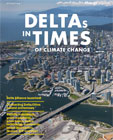The European Alps adapt to changing water resources
 The Alps play a crucial role in capturing and supplying water to Europe. Hosting the headwaters of the rivers Danube, Rhine, Po and Rhone, they deliver vital ecosystem services within and beyond the region, underpinning social and economic wellbeing in vast lowland areas. The Alpine climate has changed significantly in the past century, however, posing challenges for decision makers.
The Alps play a crucial role in capturing and supplying water to Europe. Hosting the headwaters of the rivers Danube, Rhine, Po and Rhone, they deliver vital ecosystem services within and beyond the region, underpinning social and economic wellbeing in vast lowland areas. The Alpine climate has changed significantly in the past century, however, posing challenges for decision makers.
By Stéphane Isoard
The Alpine climate has changed significantly during the past century. As a recent study by the European Environment Agency (EEA, 2008) notes, temperatures increased by more than twice the global average in that period and are projected to increase by 2.63.9 °C above the 1990 level by 2100. Projections show a decrease in summer precipitation and, in most regions, an increase in spring and winter. Precipitation in winter will increasingly fall as rain rather than snow, leading to fewer days with snow cover. This warming and associated reductions in snow and glacier cover could have grave impacts. The hydrological cycle in the Alps will change, leading to more droughts in summer, floods and landslides in winter and higher inter-annual variability. Economic sectors, including households, agriculture, energy production, forestry, tourism and river navigation, are already vulnerable to water shortages that are projected to increase read more »
This article is a part of the magazine 'Climate Adaptation in Europe'
December 2009
 Synergos Communication
Synergos Communication





